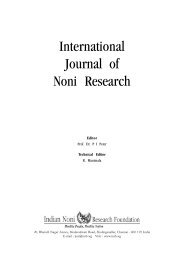International Journal of Noni Research - Noni Family
International Journal of Noni Research - Noni Family
International Journal of Noni Research - Noni Family
You also want an ePaper? Increase the reach of your titles
YUMPU automatically turns print PDFs into web optimized ePapers that Google loves.
13 Intl. J. <strong>Noni</strong> Res. 2007, 2(1-2)<br />
Table 2. <strong>Noni</strong> Fruit physical character and recovery<br />
Yield<br />
P. Rethinam et al. <strong>Noni</strong> (Morinda citrifolia L.) - the Miracle Fruit - a holistic review<br />
Fruit weight 147.9 g<br />
Length <strong>of</strong> fruit 9.8 cm<br />
Girth <strong>of</strong> fruit 5.26 cm<br />
Specific Gravity 1.13g ( wt./ vol. )<br />
Recovery <strong>of</strong> juice 38.95 - 48.50% ( range )<br />
Pulp Percentage 44.76 - 46.72<br />
Seed Percentage 3.24 - 4.31<br />
Morinda citrifolia is a perennial bush and it is possible to find fruits at<br />
different stages <strong>of</strong> maturity on the same plant at the same time. Under<br />
favorable conditions, the plant bears fruit about nine months to one year<br />
after planting. At this stage, the fruits can be harvested, but they are generally<br />
small and the yield per tree is low. Some producers choose not to harvest<br />
in the first year, and they prune in order to let the bush grow stronger. In<br />
Hawaii, <strong>Noni</strong> fruits are harvested throughout the year, although there are<br />
seasonal patterns in flowering and fruit bearing (meteorological factors,<br />
fumigation, and irrigation) (Nelson, 2001, 2003). In India the plants are<br />
allowed to grow for two years without any side growth by periodical pruning<br />
so as to make the plant sturdy. It is reported that noni plant is capable <strong>of</strong><br />
giving yield up to 250-300 kg under better cultivation conditions. after 7-8<br />
years <strong>of</strong> planting. However in the initial stages yield may range from 30-40<br />
kg per plant and the well grown tree will produce an average <strong>of</strong> 90 - 100<br />
kg per tree. It is also reported that the productivity <strong>of</strong> the trees will be up<br />
to 40-50 years and the harvest can be done more than 6 - 7 times in a year.<br />
In Hawaii, noni plots are usually harvested two or three times per month,<br />
although fruit production is lower during winter. With a density <strong>of</strong> 638 plants<br />
per hectare with good soil fertility, drainage, and irrigation and appropriate<br />
pest, disease and weed control, along with an appropriate fertilization plan,<br />
it is possible to obtain yields <strong>of</strong> between 7 tonnes/ha/year in the second year<br />
after planting to approximately 70 tonnes/ha/year after the fifth year (Nelson,<br />
2001, 2003). With a juice extraction rate <strong>of</strong> approximately 50% (w/w), one<br />
hectare can thus yield around 35 tons <strong>of</strong> juice. However, many factors may affect<br />
these yields, and most producers do not obtain such good results because <strong>of</strong><br />
diseases or poor agricultural practices (grown wild plants). In Hawaii, an average<br />
annual yield <strong>of</strong> 50 tonnes/ha is generally attained (Nelson, 2001, 2003).








